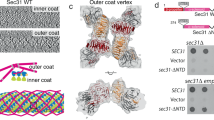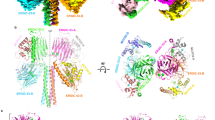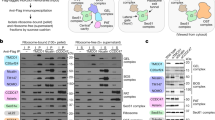Abstract
The Ml3 coat protein spans the Escherichia coli plasma membrane with its amino-terminus facing the periplasm. It is made as a precursor—the procoat—with a typical leader peptide. Mutations which destroy the basic character of the carboxy-terminal domain of procoat, a domain which is oriented towards the cytoplasm, block membrane assembly, while insertion of three lysyl residues near the carboxy terminus partially restores assembly. Thus the information specifying membrane insertion of M13 procoat protein is found in its mature region as well as the leader and is not simply decoded in an amino to carboxy direction.
This is a preview of subscription content, access via your institution
Access options
Subscribe to this journal
Receive 51 print issues and online access
$199.00 per year
only $3.90 per issue
Buy this article
- Purchase on Springer Link
- Instant access to full article PDF
Prices may be subject to local taxes which are calculated during checkout
Similar content being viewed by others
References
Milstein, C., Brownlee, G. G., Harrison, T. M. & Mathews, M. B. Nature new Biol. 239, 117–120 (1972).
vonHeijne, G. Eur. J. Biochem. 133, 17–21 (1983).
Perlman, D. & Halvorson, H. O. J. molec. Biol. 167, 391–409 (1983).
Wolfe, P. B., Silver, P. & Wickner, W. J. boil. Chem. 257, 7898–7902 (1982).
Carlson, M. & Botstein, D. Cell 28, 145–154 (1982).
Wickner, W. T. & Lodish, H. F. Science 230, 400–407 (1985).
Blobel, G. Proc. natn. Acad. Sci. U.S.A. 77, 1496–1500 (1980).
Michaelis, S. & Beckwith, J. A. Rev. Microbiol. 36, 435–465 (1982).
Koshland, D., Sauer, R. T. & Botstein, D. Cell 30, 903–914 (1982).
Ito, K. & Beckwith, J. Cell 25, 143–150 (1981).
Ito, K., Date, T. & Wickner, W. J. biol. Chem. 255, 2123–2130 (1980).
Koshland, D. & Botstein, D. Cell 20, 749–760 (1980).
Randall, L. L. Cell 33, 231–240 (1983).
Moreno, F. et al. Nature 286, 356–359 (1980).
Kadonaga, J. T. et al. J. biol. Chem. 259, 2149–2154 (1984).
Hall, M. H., Schwartz, M. & Silhavy, T. J. J. molec. Biol. 156, 93–112 (1982).
Wickner, W. Proc. natn. Acad. Sci. U.S.A. 73, 1159–1163 (1976).
Wolfe, P. B., Rice, M. & Wickner, W. J. biol. Chem. 260, 1836–1841 (1985).
Date, T. & Wickner, W. T. J. Virol. 37, 1087–1089 (1981).
Date, T., Goodman, J. M. & Wickner, W. Proc. natn. Acad. Sci. U.S.A. 77, 4669–4773 (1980).
Date, T., Zwizinski, C., Ludmerer, S. & Wickner, W. Proc. natn. Acad. Sci. U.S.A. 77, 827–831 (1980).
Wickner, W. Trends biochem. Sci. 8, 90–92 (1983).
Kuhn, A. & Wickner, W. J. biol. Chem. 260, 15907–15913 (1985).
Kuhn, A. & Wickner, W. J. biol. Chem. 260, 15914–15918 (1985).
Dierstein, R. & Wickner, W. EMBO J. (in the press).
Goff, S. & Goldberg, A. L. Cell 41, 587–595 (1985).
Blobel, G. & Dobberstein, B. J. Cell Biol. 67, 852–862 (1975).
Wickner, W. A. Rev. Biochem. 48, 23–45 (1979).
Oliver, D. B. & Beckwith, J. Cell 25, 765–772 (1981).
Wolfe, P. B., Wickner, W. & Goodman, J. J. biol. Chem. 258, 12073–12080 (1983).
Bankaitis, V. A., Rasmussen, B. A. & Bassford, P. J. Jr Cell 37, 243–252 (1984).
Miller, J. Experiments in Molecular Genetics (Cold Spring Harbor Laboratory, New York, 1972).
Zalkin, H., Yanofsky, C. & Squires, C. L. J. biol. Chem. 249, 465–475 (1974).
Author information
Authors and Affiliations
Rights and permissions
About this article
Cite this article
Kuhn, A., Wickner, W. & Kreil, G. The cytoplasmic carboxy terminus of M13 procoat is required for the membrane insertion of its central domain. Nature 322, 335–339 (1986). https://doi.org/10.1038/322335a0
Received:
Accepted:
Issue Date:
DOI: https://doi.org/10.1038/322335a0
Comments
By submitting a comment you agree to abide by our Terms and Community Guidelines. If you find something abusive or that does not comply with our terms or guidelines please flag it as inappropriate.



